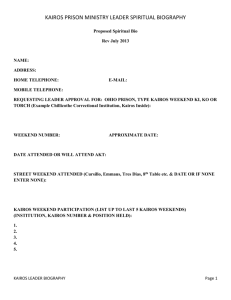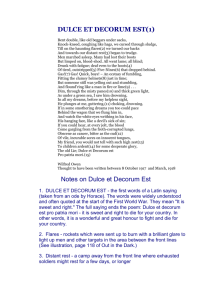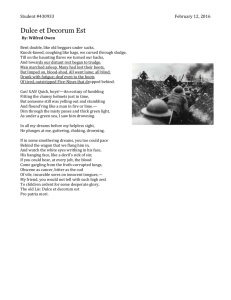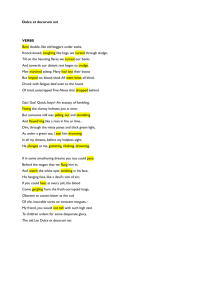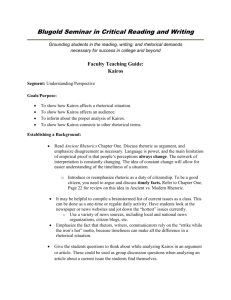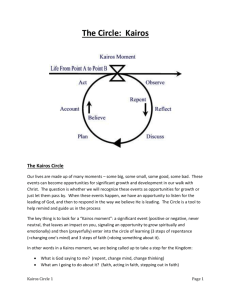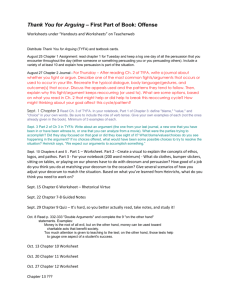Rhetorical Theory: Kairos and Decorum
advertisement
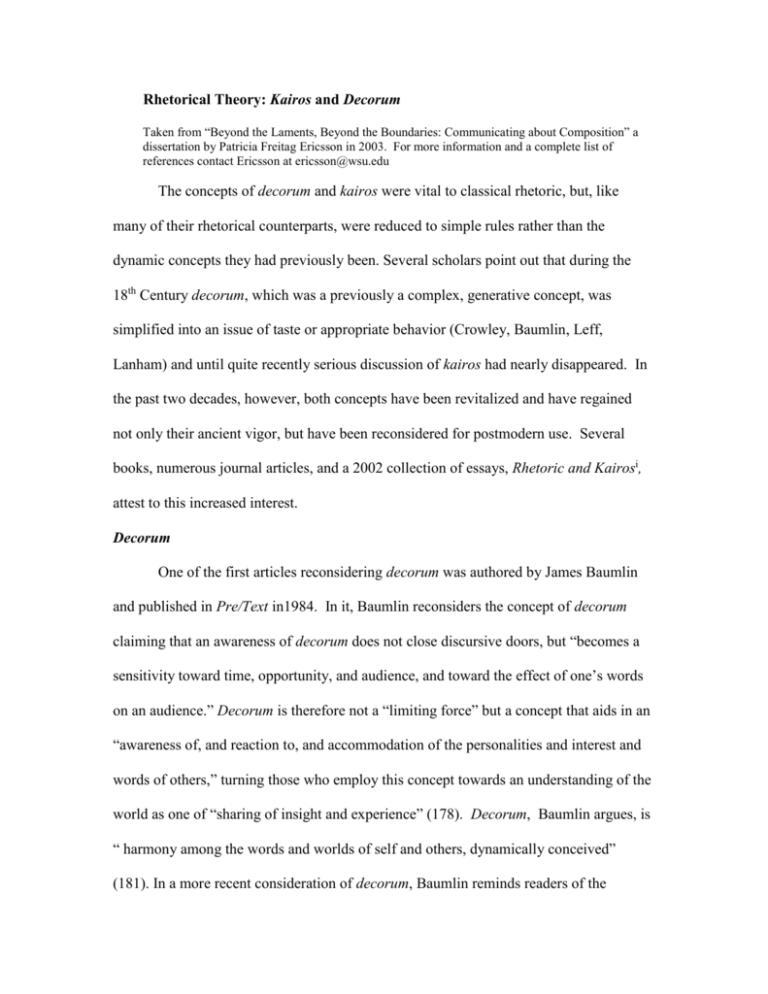
Rhetorical Theory: Kairos and Decorum Taken from “Beyond the Laments, Beyond the Boundaries: Communicating about Composition” a dissertation by Patricia Freitag Ericsson in 2003. For more information and a complete list of references contact Ericsson at ericsson@wsu.edu The concepts of decorum and kairos were vital to classical rhetoric, but, like many of their rhetorical counterparts, were reduced to simple rules rather than the dynamic concepts they had previously been. Several scholars point out that during the 18th Century decorum, which was a previously a complex, generative concept, was simplified into an issue of taste or appropriate behavior (Crowley, Baumlin, Leff, Lanham) and until quite recently serious discussion of kairos had nearly disappeared. In the past two decades, however, both concepts have been revitalized and have regained not only their ancient vigor, but have been reconsidered for postmodern use. Several books, numerous journal articles, and a 2002 collection of essays, Rhetoric and Kairosi, attest to this increased interest. Decorum One of the first articles reconsidering decorum was authored by James Baumlin and published in Pre/Text in1984. In it, Baumlin reconsiders the concept of decorum claiming that an awareness of decorum does not close discursive doors, but “becomes a sensitivity toward time, opportunity, and audience, and toward the effect of one’s words on an audience.” Decorum is therefore not a “limiting force” but a concept that aids in an “awareness of, and reaction to, and accommodation of the personalities and interest and words of others,” turning those who employ this concept towards an understanding of the world as one of “sharing of insight and experience” (178). Decorum, Baumlin argues, is “ harmony among the words and worlds of self and others, dynamically conceived” (181). In a more recent consideration of decorum, Baumlin reminds readers of the complexity of decorum for classical Greeks and Romans. Like many contemporary scholars considering decorum, Baumlin cites from Cicero’s Orator: In an oration, as in life, nothing is harder to determine than what is appropriate. The Greeks call it prepon; let us call it decorum or ‘propriety.’ . . . From ignorance of this mistakes are made not only in life but very frequently in writing, both in poetry and in prose. . . . For the same style and the same thoughts must not be used in portraying every condition in life, or every rank, position or age, and in fact a similar distinction must be made in respect of place, time and audience. The universal rule, in oratory as in life, is to consider propriety [quid deceat est considerandum] (qtd. in Baumlin 141). Both Richard Lanham and Michael Leff have reinterpreted decorum meaningfully for contemporary use. In his recent considerations of decorum, Lanham maintains that the concept of decorum “could use some rethinking” (A Handlist 45). Like others who have considered the concept, he considers decorum almost invisible— visible only when it is missing. “Decorum, not to put too fine an edge on it, amounts to a pious fraud, the ‘social trick’ par excellence” (46). Although we must consciously make sure that our rhetorical utterances adhere to accepted decorum (unless we are deliberately attempting to undermine what is accepted), once we have done that, we somehow “agree to forget that we have created it and to pretend that it is nature itself we are engaging with” (46). Part of being a successful rhetorician and comprehending decorum is often, as Lanham puts it, a “test of acculturation,” and what other theorists might call “tacit knowledge” (46). Decorum may be related to habitus as conceived by Pierre Bourdieu, although certainly not identical to it. Habitus, Bourdieu says, is constituted by “systems of durable, transposable dispositions, structured structures predisposed to function as structuring structures” and that “the practices produced by the habitus” always tend “to reproduce the objective structures of which they are the product, they are determined by the past conditions which have produced the principle of their productions” (72). In his discussion of Bourdieu, Jay Lemke notes that Bourdieu “speaks of culture as directly embodied in persons” (33) and attributes to Bourdieu the idea of a “linguistic habitus” which he defines as “some embodied system of dispositions to speak in a particular way” (43). Although there may be parallels in the concepts of linguistic habitus and decorum, to equate them would be a mistake. Decorum is a generative concept that requires the rhetor to consider the habitus and not assume that all audiences are the same. The practice of decorum demands that the rhetor attempt to make the habitus—that which is invisible, embodied, and naturalized—visible, and then, in the rhetoric itself, make sure that it is invisible again. As Lanham notes, “We know decorum is present when we don’t notice it, and vice versa” (45). In light of discussions of habitus, decorum might be defined as an attempt to interrogate linguistic habitus in order produce rhetoric more sensitive to it. In his ground-breaking 1999 article, “The Habitation of Rhetoric,” Michael Leff contends that decorum requires “unity of thought and expression” (62) and thus illuminates another facet of this complex concept. Leff argues that although decorum may have become “associated exclusively with style” that decorum-as-style-only has not always been the case since “pre-modern rhetorical theory grants a much wider application for decorum—one that embraces cognitive as well as stylistic concerns” (61). Leff claims that Our mode of representing situations and our assessment of their nature and moral significance coalesce within the structure of rhetorical judgment. And, in fact, the most skillfully constructed rhetorical discourses blend these elements so as to render them indistinguishable. This artistic skill is neither cosmetic nor deceptive. Instead, it reflects the unity of thought and expression necessary for the comprehension and direction of life in the pluralistic space of public experience. (62) This required “unity of thought and expression” is well characterized by the term decorum. Leff says that the principle of decorum “orders the elements of a discourse and rounds them out into a coherent product relevant to the occasion” and, more importantly, the location of decorum must depend on the “particular case” and is thus not something that can be strictly formulated in abstract principles. Leff’s decorum is placed “between action and production” making it impossible to give decorum a “substantive stability,” but allowing it to be a “constantly moving process of negotiation,” a “nomadic process” (62). Kairos Like scholars who have reconsidered decorum, those investigating kairos often go back to its ancient origins. The work of Eric Charles White is especially helpful when trying to recover the complexities of this concept. He explains that the word means “the right moment” or “the opportune.” These meanings, he says, come from different sources: archery and weaving. In archery, kairos refers to an opening or a “long tunnel- like aperture through which the archer’s arrow has to pass.” This requires that the arrow be fired both accurately and with enough power for it to penetrate. In weaving, kairos refers to the “critical time” when the “weaver must draw the yarn through a gap that momentarily opens in the warp of the cloth being woven.” White continues, asserting that when we put the two concepts together, we have a concept of kairos that refers to “a passing instant when an opening appears which must be driven through with force if success is to be achieved” (qtd. in Sipiora 18). White’s concept of kairos conflates temporal and spatial metaphors which are a part of its later understanding, but it must be noted that kairos is markedly different from chronos which was, to the Classical Greeks, a measure of “absolute, universal, and objective” time. In contrast, kairos is “interpretive, situational, and thus, ‘subjective’“ (Benedikt 226). In yet another consideration of kairos, Phillip Sipiora emphasizes what Isocrates considered a vital component of apprehending kairos: phronesis. Phronesis, or practical wisdom, must be “coupled with kairos” for there to be “effective rhetoric” and both kairos and phronesis must be “part of a speaker’s value system as it translates into social action” (9). Sipiora contends that phronesis plays two roles: “phronesis is necessary for the activation of a preliminary, ‘internal’ dialectic which, in turn gives rise to an ‘intelligence’ that expresses itself in words and actions. This derived intelligence is based upon a rhetor’s understanding of kairos” (9). Isocrates himself considers kairos one of the essential elements in discourse and emphasizes it as a “dynamic principle rather than a static, codified rhetorical technique” (10). In Antidosis Isocrates says “[T]hose who must apply their minds to [discourse situations] and are able to discern the consequences which for the most part grow out of them, will most often meet these situations in the right way” (qtd. in Sipiora 10). In marking the difference between decorum and kairos, the recent work of Joseph J. Hughes claims that the rhetor must be able to apprehend and assess kairos, and then be able to address the situation “within the bounds of decorum” (128). This is a vital distinction and awareness of it makes both concepts more understandable and usable. Combining the Theories Recent scholarship concerning decorum and kairos has served to rehabilitate the concepts, but what role can they play in a postmodern, ecosocial theory of agency? Although Lemke, Kingdon, or Sabatier and Jenkins-Smith do not mention these concepts, a sense of them infuses their work. Early in his chapter on “Discourse and Social Theory,” Lemke says that “we need a general social theory to help us understand how the discourse habits of the community around us both shape our own discourses and viewpoints and provide us with resources for saying and doing things that are new but still make sense to others” (19). This theory, he argues must be “active,” illustrate a “dynamic community,” but must also be “critical and unitary” (20). Lemke offers ecosocial theory as a model for this dynamic community and later in the book suggests “critical praxis” as a way to “examine ourselves, examine our actions, beliefs, and values to see how they connect up to the larger patterns and processes of the system of which we are a part, to understand how we are a part of the problem in order to have any hope of becoming a part of the solution” (131). Critical praxis is, however, too broad a concept to help us in our everyday lives. Decorum, however, in its revitalized, analytical, generative form, is the concept that allows for a practical, everyday critical discursive praxis. Decorum involves the examining and understanding that Lemke demands, but it also moves to action; decorum comes to fruition in speaking, writing, and representing. Sabatier and Jenkins-Smith’s ACF would benefit from considerations of decorum as well. Policy-oriented learning, which requires conversation and debate amongst different belief systems and has, at its core, an “ongoing process of search and adaptation” (44), demands a concept like decorum that can provide for critical analysis in the discursive arena as well as a theory of practice. ACF notes that change can come about when different advocacy coalitions engage in debate or “informed conflict,” when the coalitions meet in a venue that is informed by “professional norms” (50-54). Although Sabatier and Jenkin-Smith portray professional norms as unifying, these very norms are often the source of serious misunderstandings in discussion between advocacy coalitions. As Iris Marion Young points out, “In a discussion in which different people with different aims, values, and interests seek to solve collective problems justly, it is not enough to make assertions and give reasons. One must also be heard” (71). She argues that, “rhetoric announces the situatedness of communication” and through rhetoric the “speaker, audience, and occasion” are constructed. This is the practice of decorum. Informed by decorum, the project of policy-oriented learning can move beyond an assumption that professional norms are enough and that an adherence to them (however vague and misunderstood they may be) is good enough to assure productive discussions. Not only does decorum allow for an analytical awareness of how complicated being heard actually is, it also provides guidance on how to be heard. As Lanham notes, decorum may be the “‘social trick’ par excellence” but it is not necessarily a trick of deceit or deception. It is a requirement of effective discourse and without it, little can be accomplished. A similarly persuasive argument for the use of kairos to enhance and improve the theories of the ecosocial, MST, and ACF can also be made. Although Lemke believes that we do not know enough about “critical moments” to know when to act (129), he does note that we can examine the process through which “alternatives” are offered and study the “conditions of their survival” (129). I suggest that the concept of kairos is just what we need to employ to know enough about critical moments to make predictions about whether our actions will meet with any success. Lemke suggests that examining processes and studying conditions are part of agency, and these steps are, most assuredly, part of kairos. The accomplished archer or the skilled weaver must learn, through study and practice, the processes and conditions that allow for accuracy as well as the force needed to accomplish the goal. Those wanting to effect change in ecosocial systems must study processes and conditions in subsystems and learn, by practice as well as study, what kind of strength and intensity might be needed to accomplish their goals. Adding public policy theory to considerations of kairos can offer a helpful focus. Kingdon’s focus on the three streams (problems, policies, and politics) and the existence of policy windows suggests kairos, but his explanation is limited. With the addition of a revitalized conception of kairos, the idea of a policy window becomes invaluable. By combining Kingdon’s streams with kairos, a specialized version of kairos can be created: polikairos.ii Simply stated, polikairos is an analytical and generative concept, influenced by close attention to problems, policies, and politics, and used for both assessing the opportune time for a political move and guiding the force of that move. Although ACF does not have anything like a policy window as part of its structure, the central idea of “policy-oriented learning” as well as the assertion that policy change takes place over time edges towards consideration of kairos. Those working within advocacy coalitions need to have a well-developed sense of polikairos in order to carry on effective policy-oriented learning—to know when to step into “debate” with other advocacy coalitions, to know what kinds of arguments to make, and to know with what force those arguments must be made to be successful. i In her positive review of this book in Rhetoric Review, Sharon Crowley says that those who expect a simple definition of kairos from it "will not be made happy by reading this collection" (83). I agree that the complications of defining both decorum and kairos are many. However, the lack of an easy of definition of decorum or kairos does not preclude their use, nor their generative possibilities. In fact, their slippery nature may make them particularly appropriate for postmodern application. ii I employ this term, not to suggest an expansive notion of kairos (as the term polykairos would), but to suggest a narrowed focus—a type of kairos that focuses on a political version of kairos.
